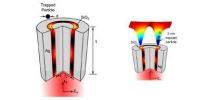(Press-News.org) The study, by IIASA Evolution and Ecology Program postdoctoral fellow Tatsuya Sasaki, provides a simple new model that ties punishment by social exclusion to the benefits for the punisher. It may help explain how social exclusion arose in evolution, and how it promotes cooperation among groups.
"Punishment is a common tool to promote cooperation in the real world," says Sasaki. "And social exclusion is a common way to do it." From reef fish to chimpanzees, there are many examples of animals that promote cooperation by excluding free riders. Humans, too, use social exclusion as a way to keep people following societal rules. For example, says Sasaki, traffic violators or drunk drivers may be punished by losing their drivers licenses, essentially excluding them from the driving community.
But how did such punishment evolve? The new research, which uses evolutionary game theory, shows that excluding people from a group indirectly provides rewards for the punisher, thus encouraging them to exclude those they have reason to punish.
"Imagine a pie," says Sasaki. The fewer people sharing that pie, the more pie everyone gets. But you can't deny people pie for no reason. There needs to be a justification, for example, that someone did not contribute to baking the pie—a free rider, in game theory parlance. Sasaki says, "If you punish free riders with social exclusion, it increases the payoff for the punishers."
Social exclusion also promotes cooperation, the study shows. If free riders are denied a piece of the pie, people will be more likely to cooperate and ensure they get to share in the reward.
Previous studies in evolution and game theory have mostly focused on other punishments that are more costly for the punisher. While a few studies have included social exclusion as one possible punishment, Sasaki's work is the first to connect exclusion to the benefits for the punishers.
The study also compared social exclusion and costly punishment, showing that social exclusion could more easily emerge in a model system, and that it is maintained more easily than costly punishment.
The work has potential applications beyond biology, for example in understanding international cooperation. "It is important to understand how we have achieved some degree of cooperation across all kinds of collective enterprises that are important to local groups or to humankind at large," says Sasaki, "In all such cases, our analysis could help design intervention strategies that enable future increases in cooperation."
Tatsuya Sasaki has just accepted a second appointment as a project postdoctoral fellow at the University of Vienna.
###
Reference
Sasaki, T. and S. Uchida. 2012. The evolution of cooperation by social exclusion. Proceedings of the Royal Society B. 5 December, 2012. doi:10.1098/rspb.2012.2498
For more information please contact:
Tatsuya Sasaki
Guest Postdoctoral Research Scholar
Evolution and Ecology
Tel: +43(0) 2236 807 590
sasakit@iiasa.ac.at
Katherine Leitzell
IIASA Press Office
Tel: +43(0) 2236 807 316
Mobile: +43(0) 676 83 807 316
leitzell@iiasa.ac.at
About IIASA:
IIASA is an international scientific institute that conducts research into the critical issues of global environmental, economic, technological, and social change that we face in the twenty-first century. Our findings provide valuable options to policy makers to shape the future of our changing world. IIASA is independent and funded by scientific institutions in Africa, the Americas, Asia, Oceania, and Europe. www.iiasa.ac.at
Philadelphia, PA, December 4, 2012 – A new study of working women has identified factors during pregnancy and postpartum that can predict pain in the joints that comprise the pelvic girdle. While 90 percent of working women in the Netherlands return to work after the birth of their first child, health issues during the postpartum period often require sick leave. Chief among these health issues is pelvic girdle pain (PGP).
"It is important to identify predictors for postpartum PGP, because physicians, obstetricians, midwives, and employers could use them to identify women ...
UC Davis chemists have been using a Japanese synchrotron to get a detailed look at enzymes that could help power the green economy. The work was published online Nov. 8 by the journal Angewandte Chemie and is featured on the cover of the Nov. 26 issue.
One option for powering clean, environment friendly vehicles is to run them on hydrogen fuel rather than carbon-based fuels. Cheap catalysts to prepare hydrogen gas (H2) are key to this future "hydrogen economy."
Current man-made catalysts are based on the rare and precious metal platinum. But living cells contain enzymes ...
December 4, 2012 – About 60% of infectious diseases are caused by viruses, bacteria and other pathogens that make the jump to humans from other species. This includes some of the most devastating disease outbreaks of the past 30 years, including HIV/AIDS, Ebola, and SARS. Despite the huge and rising toll of such diseases, many gaps remain in our understanding of how these "zoonoses" evolve, develop, and spread—gaps that must be filled if we are to succeed in preventing or at least reducing the impact of a next pandemic.
A new paper published in the Lancet by Stephen ...
Scientists using NASA satellite data and climate models have projected drier conditions likely will cause increased fire activity across the United States in coming decades. Other findings about U.S. wildfires, including their amount of carbon emissions and how the length and strength of fire seasons are expected to change under future climate conditions, were also presented Tuesday at the annual meeting of the American Geophysical Union in San Francisco.
Doug Morton of NASA's Goddard Space Flight Center in Greenbelt, Md., presented the new analysis of future U.S. fire ...
The population of the United States is getting older, due not only to aging boomers but also to a four-year increase in life expectancy from 1990 to 2010. An aging population means increased diagnosis of prostate cancer. Statistically, the older the patient at time of diagnosis, the more aggressive the disease – and also the less well the patient is likely to tolerate traditional chemotherapies. In sum, we have more, aggressive prostate cancer that can't be targeted by traditional treatments.
Members of the University of Colorado Cancer Center recently published a review ...
Buildings and statues constructed of limestone can be protected from pollution by applying a thin, single layer of a water-resistant coating.
That's the word from a University of Iowa researcher and her colleagues from Cardiff University in a paper published in the journal Scientific Reports, from the publishers of Nature. In the study, the researchers report a new way to minimize chemical reactions that cause buildings to deteriorate, according to Vicki Grassian, F. Wendell Miller professor in the UI departments of chemistry and chemical and biochemical engineering.
The ...
New Rochelle, NY, December 4, 2012—About 30 million women in the U.S. have osteoporosis, with low bone mass and deteriorating bone structure that increases their risk for fractures. Racial differences in the rates of detection and management of osteoporosis were explored in a study of African American and white women published in Journal of Women's Health, a peer-reviewed publication from Mary Ann Liebert, Inc., publishers. The article is available free on the Journal of Women's Health website at http://www.liebertpub.com/jwh.
The study, "Osteoporosis Health Care Disparities ...
No man is an island, entire of itself, said poet John Donne. And no atom neither. Even in the middle of intergalactic space, atoms feel the electromagnetic field---also known as the cosmic microwave background---left over by the Big Bang. The cosmos is filled with interactions that remind atoms they are not alone. Stray electric fields, say from a nearby electronic device, will also slightly adjust the internal energy levels of atoms, a process called the Stark effect. Even the universal vacuum, presumably empty of any energy or particles, can very briefly muster virtual ...
URBANA – A detailed annotation of the genome of T.J. Tabasco, a pig from the University of Illinois South Farms, is the outcome of over 10 years of work by an international consortium. It is expected to speed progress in both biomedical and agricultural research. U of I Vice President for Research Lawrence Schook said that the College of ACES played a crucial role in getting the work started.
Funding that came through ACES allowed Schook and others to put together the Swine Genome Sequencing Consortium, an alliance of university, industry, and government laboratories ...
To grasp and move microscopic objects, such as bacteria and the components of living cells, scientists can harness the power of concentrated light to manipulate them without ever physically touching them.
Now, doctoral student Amr Saleh and Assistant Professor Jennifer Dionne, researchers at the Stanford School of Engineering, have designed an innovative light aperture that allows them to optically trap smaller objects than ever before – potentially just a few atoms in size.
The process of optical trapping – or optical tweezing, as it is often known – involves sculpting ...



